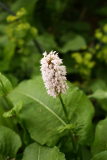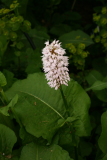Additional notes (click to expand)
Medicinal
Culpeper: “... taken inwardly resist pestilence and poison, helps ruptures, and bruises, stays fluxes, vomiting and immoderate flowing of the terms in women, helps inflammations and soreness of the mouth, and fastens loose teeth, being bruised and boiled in white wine and the mouth washed with it.”
Culpeper, Nicholas. (1650). A Physical Directory . London, Peter Cole.
In modern herbal medicine it is still used for a similar wide variety of internal conditions, but it can also be cooked and eaten as a vegetable. The use to relieve toothache, applied as a paste to the affected tooth, seems to have been widespread.
Oakeley, Dr. H. F. . (2013). The Gardens of the Pharmacopoeia Londinensis.
link
Nomenclature
Previously grown as Persicaria bistorta (10/12/20)
(fda)
Plants of the World online, Kew Science http://www.plantsoftheworldonline.org/taxon/urn:lsid:ipni.org:names:60430545-2
link
Geographical distribution
- Africa, Northern Africa
- Asia-Temperate
- Asia-Tropical, Indian Subcontinent, Pakistan
- Europe
- Europe, Northern Europe, Great Britain
Bistorta officinalis Delarbre
Family: POLYGONACEAEGenus: Bistorta
Species: officinalis Delarbre
Common names: Bistort, Snakeweed, Easter Ledges
Pharmacopoeia Londinensis name: Bistorta sive serpentaria
Distribution summary: Europe, N.& W.Asia
Habit: Perennial
Hardiness: H7 - Very hardy
Habitat: Damp meadows, sandy streamsides
Garden status: Currently grown
Garden location: Pharmacopoeia Londinensis 1618 'Roots' (HSE 2)
Flowering months: June, July, August, September
Reason for growing: Medicinal
.JPG)

